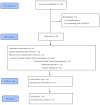The Effect of Combining Transcranial Direct Current Stimulation Treatment and an Exercise Program on Fragility in a Population with Multiple Sclerosis: Cross-Over Design Trial
- PMID: 36232045
- PMCID: PMC9566021
- DOI: 10.3390/ijerph191912747
The Effect of Combining Transcranial Direct Current Stimulation Treatment and an Exercise Program on Fragility in a Population with Multiple Sclerosis: Cross-Over Design Trial
Abstract
Background: The relationship between fragility and neurological diseases is extensive and affects many patients with multiple sclerosis (MS), whose risk factors are related to fragility.
Objective: To study the effects of exercise and transcranial direct current stimulation (tDCS) in MS patients with fatigue from four dimensions: functional mobility, balance, fatigue, and depression.
Methods: A total of 12 patients who belonged to two associations of people with physical disabilities participated. Functional mobility, depression, balance, and fatigue were assessed before and after the intervention. Transcranial direct current stimulation and the exercise program were carried out over a 4-week period with a wash-out period of 5 months.
Results: After the application of tDCS, we found significant improvements in balance (p < 0.05, g = 0.632), depression (p < 0.05, g = 0.402), functional mobility (p < 0.05, g = 0.297), and fatigue (p < 0.05, g = 0.526). After the exercise program, significant improvements were shown in balance (p < 0.01, g = 0.418), depression (p < 0.001, g = 0.540), functional mobility (p < 0.01, g = 0.262), and fatigue (p < 0.01, g = 0.742). Two-way mixed-measures ANOVA showed that all variables improved in both groups, with significant differences over time but not between groups. Secondary analysis showed significant correlations between balance and functional mobility (r = 0.671, p = 0.017), depression and fatigue (r = 0.586, p = 0.044) and between intensity of rehabilitation and balance (r = 0.622, p = 0.031).
Conclusion: Participating in an exercise program and receiving tDCS separately improved the variables of depression, balance, mobility, and fatigue.
Keywords: balance; depression; functional mobility; physical training.
Conflict of interest statement
The authors declare no conflict of interest.
Figures


References
Publication types
MeSH terms
LinkOut - more resources
Full Text Sources
Medical

